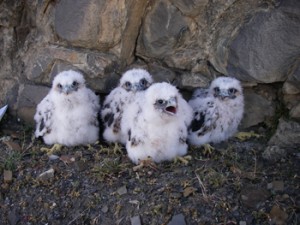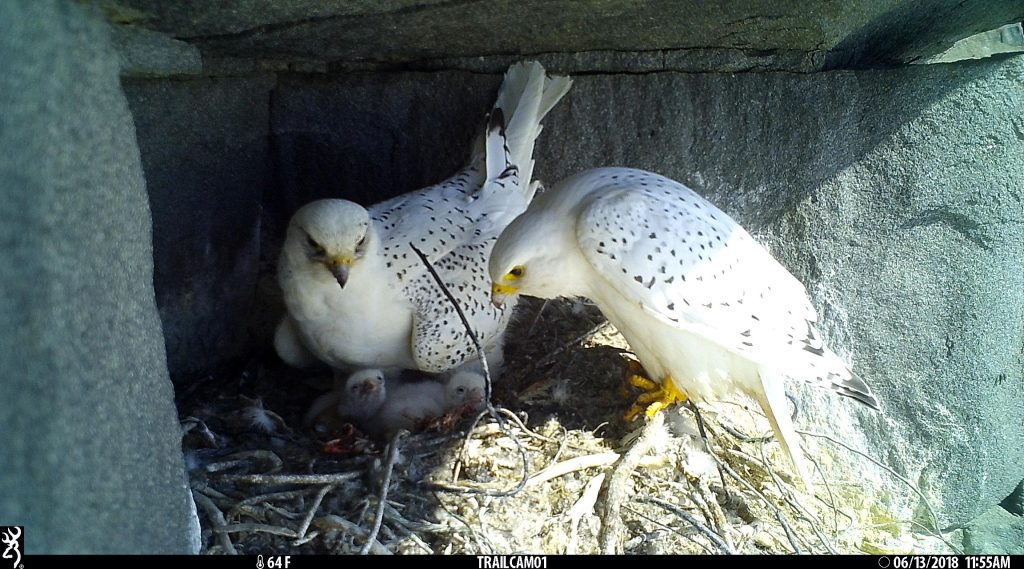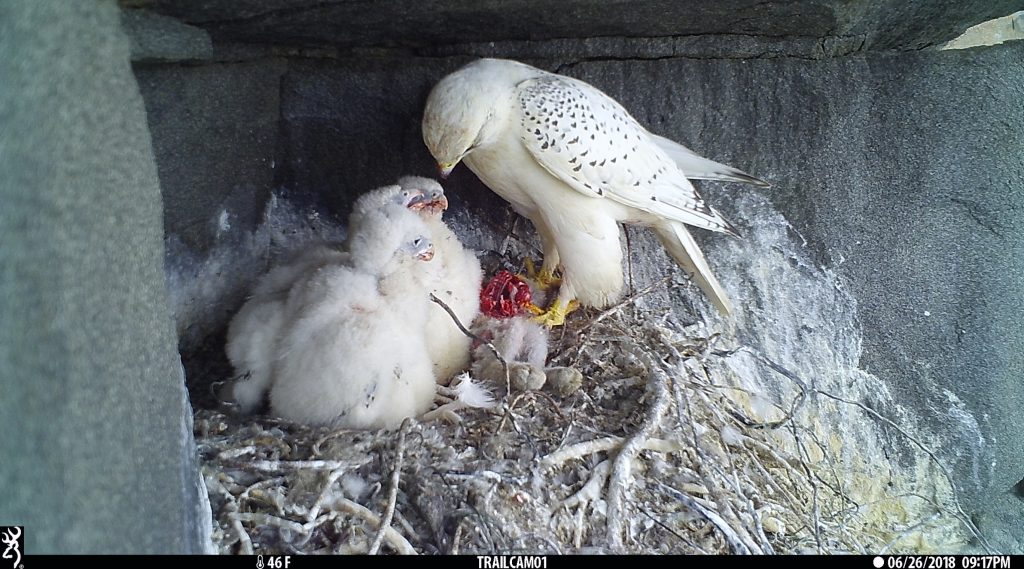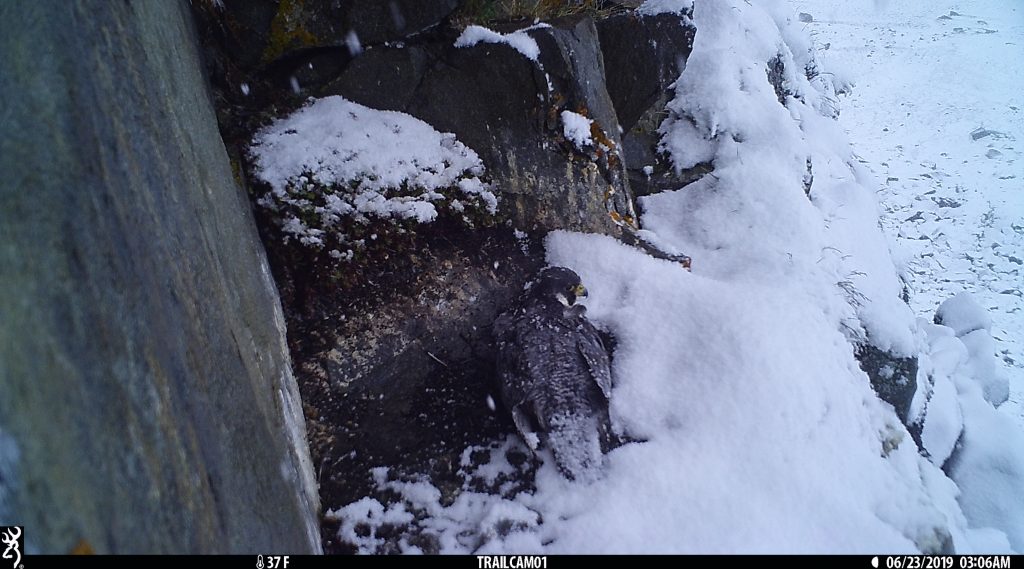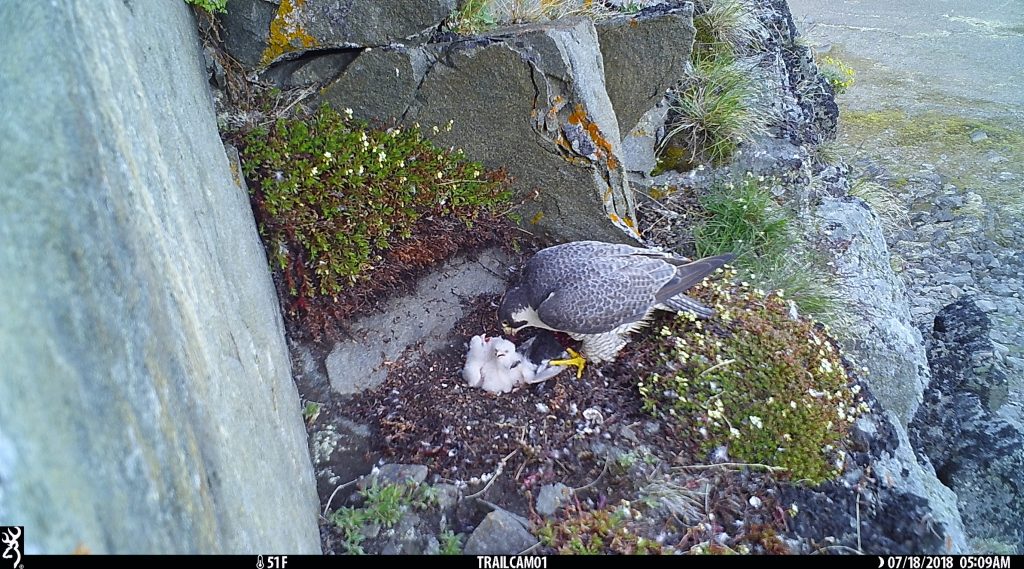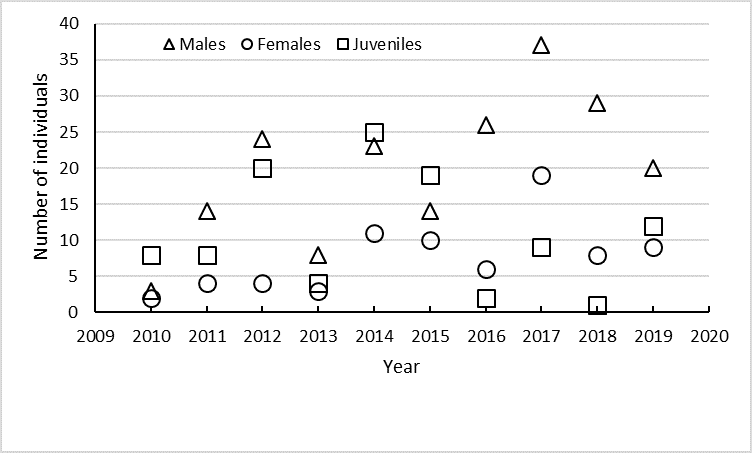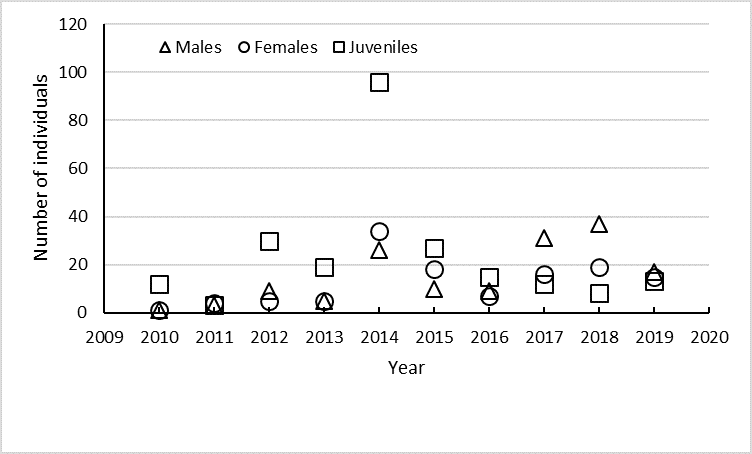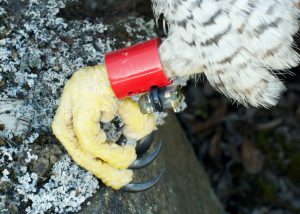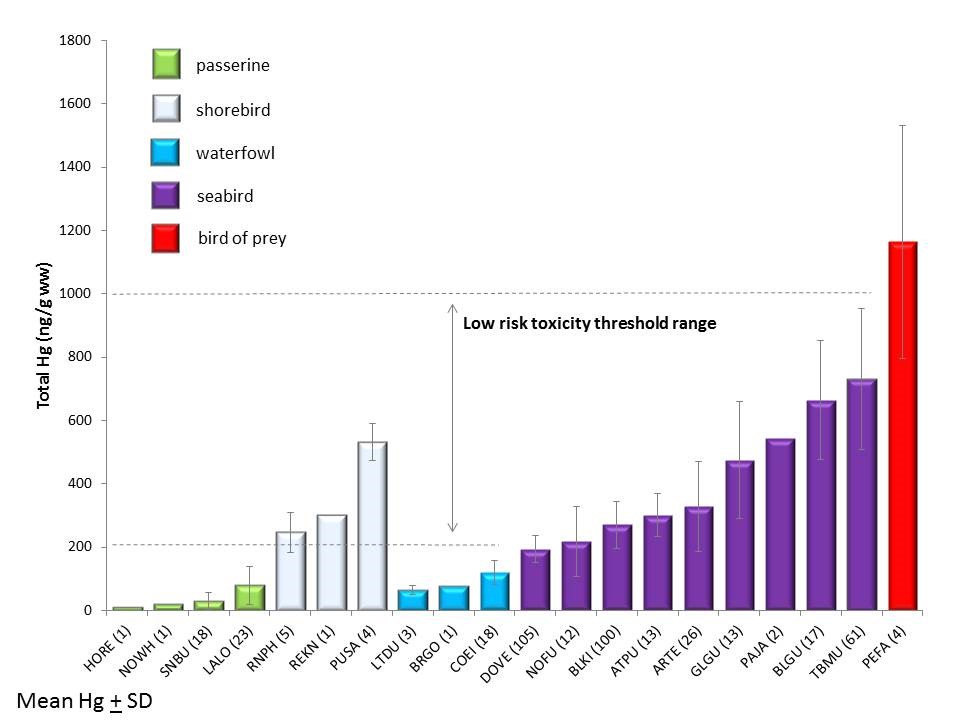GREENLAND MAP
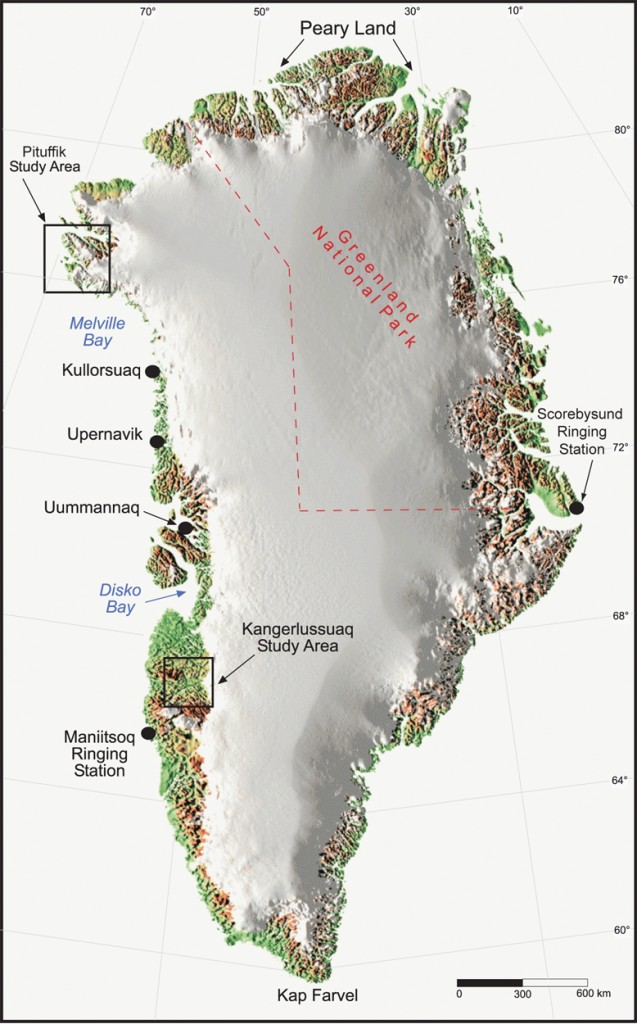
CURRENT STUDIES AND PROJECTS:
Pituffik/Thule Area, northwest Greenland
Peregrine Falcon and Gyrfalcon Monitoring
History, objectives, and previous results of project: Systematic surveys for nesting Peregrine Falcons and Gyrfalcons have occurred in the Thule area every year since 1993, with our primary study area of approximately 750 km of coastline being established in 2001. Each year this coastline is surveyed for breeding and non-breeding falcons. At locations where nesting is observed, data are recorded on reproduction, nesting chronology, and nest site characteristics. When possible, chicks are banded and sampled and molted feathers, egg shell fragments, and prey remains are collected, all to be used in other projects (e.g., adult turnover studies, pollutant analysis, stable isotopes, genetics).
Previous results from this project include the documentation of a recently established and increasing population of Peregrines, and the first-ever long-term studies on High Arctic populations of both Peregrines and Gyrfalcons. Highlights from the Gyrfalcon research include a significant advancement of lay date from 1993 to current (nesting earlier, likely associated with changing environment) in addition to the first-ever information on diet and reproduction for a High Arctic population.
Results from 2019: In our primary study area all 18 known Peregrine Falcon nest sites were surveyed and 15 out of 20 (75%) of known Gyrfalcon nest sites were surveyed for occupancy. Pairs of Peregrines were observed at 9 of the 18 surveyed locations (50%) while pairs of Gyrfalcons were observed at 7 of the 16 surveyed locations (44%). No new nests were found. This marks the second consecutive season the number of occupied Peregrine nests has declined, possibly a carry-over effect of the extremely cold and wet summer in 2018. Of particular interest, several nests which have had Peregrines for three or more consecutive years were vacant.
Objectives for 2020: Survey all the coastline and inland cliffs from 76.00°N to 77.0°N for Peregrine Falcons and Gyrfalcons. At occupied cliffs, determine if falcons are breeding and if yes, emphasis will be placed on installing nest cameras (see below) when possible.
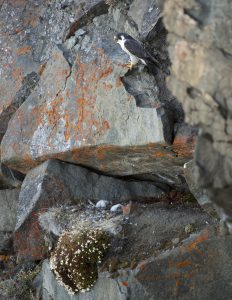 |
|
| Adult female peregrine and chicks. | Peregrine falcon chicks at the most northern known Peregrine nest in the world. |
Peregrine and Gyrfalcon Nest Camera Study
History, objectives, and previous results of project: We are working on multiple collaborative research projects with colleagues studying falcons in other parts of the Arctic and it has become clear that we need to collect better information on annual reproduction and nesting chronology. Surveys for breeding falcons in northwest Greenland occur from late June through early August. During this period, Gyrfalcon young are usually at a minimum half grown, and in many instances have departed the nest by mid-to-late July. Peregrines nest about one month later, and young frequently don’t hatch until mid-July at the earliest. In many instances our nest visits result in us finding pairs of Peregrines incubating eggs or brooding small young and Gyrfalcon young that have already fledged. These scenarios provide us very little information on reproduction (and nesting chronology, since we don’t know when the eggs hatched), since not all eggs hatch and frequently a portion of young die before ever departing the nest.
In hopes of increasing our knowledge on falcon reproduction in the Thule area, during the 2017 field season we began installing nest cameras at both Peregrine Falcon and Gyrfalcon nests. This allowed us to effectively increase the length of our field season without needing to have a team in Greenland for multiple additional months. In 2017 we took the approach of installing two types of cameras in many nests, short-term cameras, with a life expectancy of only two-to-three months, and long-term cameras, with a life expectancy of 12 to 16 months.
Results from 2018 showed that two types of cameras were not needed, and that battery life in the cold Arctic environment is much better than anticipated. All cameras functioned through the breeding season they were installed in until their removal the following summer. This allowed us to collect data from when falcons first arrived at nests up until they departed for outward migration. Additionally, we had surprising results during winter months, for example, ravens utilizing well protected Gyrfalcon nests for extended periods of time. At cliffs where falcons moved nest ledges from 2018 to 2019 (and in one case as far back as 2017) we chose to install new cameras at active, new nest ledges, and to reuse old-yet-functioning cameras in unoccupied nest ledges. This way we will hopefully still get excellent data should falcon choose to move back to recently used nest ledges.
Results from 2019: During the 2019 field season we were able to retrieve cameras from nine different Peregrine nesting cliffs (including two installed in 2017 that we were unable to retrieve in 2018), to include multiple cameras at two cliffs. All retrieved cameras were replaced with either new or reused cameras, and at all nine nesting cliffs all nest ledges occupied from 2017 onward now have active cameras. Cameras were retrieved and replaced at three Gyrfalcon nesting cliffs.
General highlights:
–at one Peregrine cliff, which was unoccupied on multiple visits, camera data showed a pair of Peregrines actively working the scrape early in the season. No idea what happened to the pair.
–similar to 2018, a dark silver female Gyrfalcon visited two nests unsuccessfully looking for a mate, although both nests were later used by white pairs.
–at multiple Peregrine cliffs it showed pairs of Peregrines dealing with snow (up to several inches) during both the incubation and young rearing period during the 2018 summer
–documented one Peregrine nest with eggs hatching in early-August and the young surviving until fledging age. Previously, we considered eggs that had not hatched by the end of July as dead or infertile.
Objectives for 2020: Re-visit all falcon nests that had cameras installed in 2019 and collect cameras and data chips. Install new cameras in active nests and old-yet-functioning cameras in recently used nests. Install cameras at any additional Peregrine and Gyrfalcon nests that are found and that are readily accessible. With the assistance of undergraduate students at Augustana College (IL), continue processing all nest camera photos collected to date to tabulate information on nesting chronology, reproduction, prey, etc.
Arctic Tern Colony Surveys
History, objectives, and previous results of study: The Thule area is the northern limit of the Arctic Tern breeding range and over the past 15 years it appears that the relatively small population of terns in this area (150–250 pairs) has declined. No historic data has ever been recorded on this population other than general estimates of colony size; however, this was only based on the number of individual birds observed flying above colonies. Starting in 2009 we began systematically surveying the seven known tern colonies (all on small islands) and all other suitable nesting locations along the 750 km of coastline we survey for nesting falcons. When occupied colonies are found, we systematically survey the colonies and record information on reproduction and breeding chronology (number of nests, number of eggs or chicks, age of young). Using this information, over the next 5–10 year period we hope to be able to determine what changes are occurring in the population, be it a reduction in the number of pairs of terns or changes in nesting chronology (e.g., nesting earlier, a common result of climate change and a warming High Arctic environment).
In 2017 we published a manuscript that included all previously collected data on the tern population in northwest Greenland and compared it with our findings from 2009 to 2017. The key findings from the manuscript showed a steady decline from approximately 250 pairs of Arctic Terns in the late 1960s to late 1980s to an average of ~50 over the past nine years. Four previously identified colonies have been extirpated while three current colonies have undergone significant reductions in size. In 2017 we found only 25 nests, the fewest to date, and continues an apparent rapid decline in the number of nesting pairs in our study area.
Results from 2019: We visited all previously known colonies and possible nesting locations and found Arctic Terns nesting at five different locations and present at a sixth. A total of 40 nests were found with 15 at one colony and an estimated 20 at another (chicks had begun to hatch so we were not able to survey, number based on adults in attendance). This is a significant improvement from the past few years, although still much lower than even 5 to 10 years ago.
Objectives for 2020: Continue surveying all islands in our study area that have previously had or are suitable for nesting Arctic Terns. These islands are in locations which are passed by while conducting surveys for falcons, and we can conduct the surveys in a relatively short amount of time. These are the only systematic surveys for Arctic Terns conducted on an annual basis anywhere in Greenland.
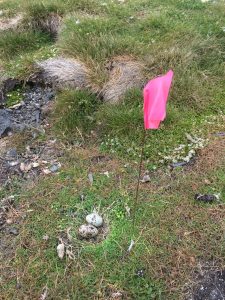 |
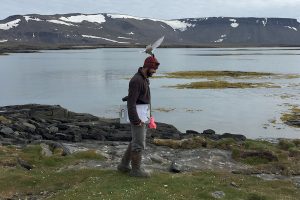 |
| Arctic Tern nest with two eggs. | Arctic Terns are extremely defensive. |
Parasitic Jaeger Geolocator Study
History, objectives, and previous results of study: Parasitic Jaegers are a long-distance migrant that breed throughout the circumpolar Arctic. Although observed in the southern hemisphere during winter months, little to no information is known regarding which migratory pathways or wintering areas different geographical breeding populations use. In northwest Greenland, Parasitic Jaegers are generally uncommon, and during a given field season we are likely to only observe a handful of individuals at most. That said, over the past 10 years we have located three breeding pairs, with the pairs returning to the same general areas to nest in successive years. This provides us with a unique opportunity to capture and tag the adults with geolocators. This information will not only provide the first specific migratory information on Parasitic Jaegers breeding in Greenland, but the species as a whole.
Results from 2019: Locations where Parasitic Jaegers were captured and tagged with geolocators in 2017 and 2018 were visited and nesting jaegers were found at one location. The individual captured and tagged with two geolocators in 2018 (one on each leg) was re-captured and still had both geolocators attached and functioning. In 2018 we chose to attach two geolocators to this individual after the single geolocator attached in 2017 fell off. We again attached two geolocators to this individual and it was released. Two new pairs were found in 2019 but it appeared that both had likely failed and thus we were unable to capture either adult.
Objectives for 2020: Recapture the single individual tagged in 2019 and search for the other individual tagged in 2017. Visit new nesting locations found in 2019 and attempt to capture and tag additional individuals.
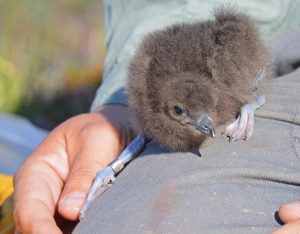 |
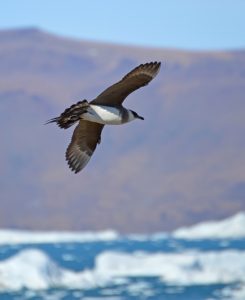 |
| Parasitic Jaeger nestling. | Parasitic Jaeger in flight. |
Snow Bunting and Lapland Longspur Monitoring
History, objectives, and previous results of study: In recent years passerine populations throughout the Arctic have been shown to be significantly influenced by rapidly changing climatic conditions. For example, the recent increase in storm events during summer months has been shown to have a detrimental effect on fledglings, greatly increasing mortality. In Thule we have noted a similar trend, with several large rain events in recent years leading to numerous dead fledglings…to the point you simply observe them lying dead when hiking the tundra. Additionally, changes in both the amount and type of precipitation during summer months (rain versus snow historically) may also be affecting insect abundance and vegetation growth, both of which passerines rely upon for food. As a result of these observed changes in 2010 we began trapping both Snow Buntings and Lapland Longspurs when weather conditions prevented us from boating. Since then we have developed a regular trap-line and protocol which we follow each summer. As of the end of 2017 we have captured over 700 different individuals, with a number of them recaptured in later years. As predicted, we have seen extremely large swings in the numbers of juveniles caught, with some years having 4–5 times more juveniles than others. Using this capture/recapture methodology we should be able to look at annual survival of both juveniles and adults, juvenile recruitment into the breeding population, and changes in the size of the population over time.
Results from 2019: We captured 41 (29 adults/12 juveniles) Lapland Longspurs and 45 (32 adults/13 juveniles) Snow Buntings, including a combined 22 re-traps. Despite overall good weather conditions throughout the summer the number of juveniles was still lower than anticipated, although much greater than 2018.
Objectives for 2020: During periods when we cannot boat we will continue to trap Snow Buntings and Lapland Longspurs. All individuals (including re-traps) will be banded, weighed, and measured. Additionally, we will begin collecting meteorological data from the Thule Air Base weather station to begin looking at what patterns we can see between weather events and number of fledglings captured each summer.
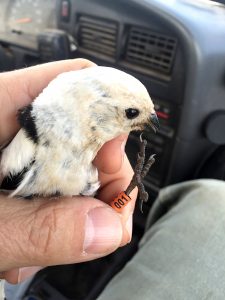 |
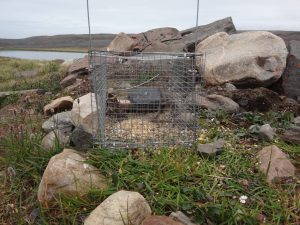 |
| Adult male Snow Bunting with orange color band. | An adult male Lapland Longspur and juvenile longspur in trap. |
Nearctic Peregrine Falcon Geolocator and Migration Study
History, objectives, and previous results of study: Over the past 20 years much information has been collected on migratory movements of Peregrine Falcons throughout their Western Hemisphere Arctic range; however, these studies occurred independently of one another and a large amount of variation can occur from year to year based on weather and prey. Starting in 2012, researchers in Southern Greenland, northwest Greenland, and Rankin Inlet (Nunavut, Canada) began a long-term and large-scale collaborative study tagging adult female Peregrines with geolocators. By collecting data from throughout this large geographic area researchers will be better able to make comparisons of migratory movements (timing and rate of migration) along with wintering areas between these populations. Furthermore, by collecting data over a long time span, we will be able to determine what changes if any are occurring in the timing of migration, along with potentially looking at how weather patterns may affect both the timing and rate of migration. The population in northwest Greenland is of particular interest since they appear to migrate farther than any other known Peregrine population in the world, and are thus more likely to be influenced by annual variation in weather patterns.
Additionally, data collected from geolocators will be compared with data collected using satellite transmitters (historic data from 2001–2004) to determine what effect, if any, satellite transmitters may have on Peregrine migration. For example, do Peregrines carrying satellite transmitters (12–20 g backpack units) travel at a slower rate when compared to Peregrines carrying geolocators (1–2 g, attached to color band)?
To date we have recovered geolocators from five adult female Peregrines. Based on results from our study area, southern Greenland, and Canada it now appears that migration duration of Peregrines wearing PTTs is significantly longer than those tagged with geolocators. While departure dates are very similar between individuals tagged with either type of unit, arrival dates at wintering areas are approximately 25 days later. This is one of the first studies of this type showing the potential detrimental effects, and bias, of using PTTs in migration studies.
Results from 2018: Unfortunately, no geolocators were recovered in 2018. Of the four tagged females from 2017 one was recaptured and both the color band (Darvic) and geolocator had fallen off, two of the females were at cliffs that were not occupied in 2018, and the fourth appeared to have lost her geolocator. This is the first year we have encountered large scale problems with geolocators falling off and plastic color bands (Darvic) failing (also see Parasitic Jaeger section). As a result, we began modifying aluminum color bands and will only use those in the future. Two new females were tagged with geolocators in 2018, one attached to a plastic Darvic color band (we did not yet have aluminum bands ready) and one to a modified aluminum color band.
Objectives for 2019: We will attempt to recover the two geolocators deployed in 2018 in addition to deploying geolocators on up to four additional female Peregrines.
 |
|
| Adult female Peregrine Falcon with geolocator. | A geolocator on an adult female Peregrine Falcon. |
Methyl Mercury and Stable Isotope Study
History, objectives, and previous results of study: While not produced in the Arctic, many pollutants (e.g., persistent organic compounds and heavy metals) that originate in mid-latitude industrialized nations are transferred to the Arctic via water and atmospheric conditions. In particular, methyl mercury has recently become a major concern, with a wide range of extremely negative effects associated with elevated levels in many bird species (e.g., abnormal incubation and feeding behavior, reduction in hatching success, etc.). Frequently, species higher up the food web (higher trophic level) have significantly greater concentrations, in particular marine-feeding bird species such as Thick-billed Murres and Black Guillemots which feed on small fish which in turn feed on smaller zooplankton.
Results from a study we conducted from 2010-12 showed (24 species, 625 samples) that 11 of the species sampled were at low risk for mercury toxicity. Of more concern, some Thick-billed Murre, Black-legged Kittiwake, and Peregrine Falcon individuals had had high enough blood mercury levels to put them at medium risk for mercury toxicity. Adult female Peregrine Falcons had the highest recorded blood mercury concentrations of any of the sampled species in our study area, which was unexpected as they generally prey on both seabirds (high mercury concentrations) and passerines (low mercury concentrations). Generally speaking, for most of the species sampled in our study they had the highest blood mercury concentrations published to date.
Results from 2019: During the 2019 field season we collected blood and feather samples from 11 different species totaling 81 samples. For the majority of species collecting occurred at the same exact locations as during our previous mercury study, which will allow us to make direct comparisons with historical data.
Objectives for 2020: Limited funding has been received to again begin intensive collection of blood mercury samples to repeat much of our study from 2010–2012. While all avian species will be targeted, particular attention will be given to species for which we had small samples sizes (e.g. shorebirds) in the previous study, species which had surprising results (e.g. very high Hg levels for their trophic position), and species/age classes for which no samples were collected (e.g. adult Gyrfalcons), and species for which similar studies are occurring elsewhere (e.g. Thick-billed Murres, Black-legged Kittiwakes, etc.).
Kangerlussuaq Area, central-west Greenland
Peregrine Falcon Monitoring
History, objectives, and previous results of study: We have monitored the Peregrine Falcon population in the Kangerlussuaq area from 1972–2006, 2008, and 2012–2013, resulting in a large number of publications. While continued large scale annual monitoring has not been possible, we attempt to survey the area every 3–5 years to collect data on reproduction, nesting chronology, and nest site characteristics. Additionally, similar to Thule, when possible chicks are ringed and sampled and molted feathers, egg shell fragments, and prey remains are collected, all to be used in other projects (e.g., adult turnover studies, pollutant analysis, stable isotopes, genetics).
Results from 2019: Approximately 20 known Peregrine Falcon nests were surveyed during 2020 and results are still be analyzed.
Objectives for 2020: Limited surveys will occur for Peregrine Falcons in the Kangerlussuaq area during summer 2020.
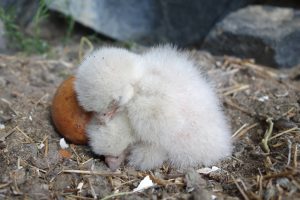 |
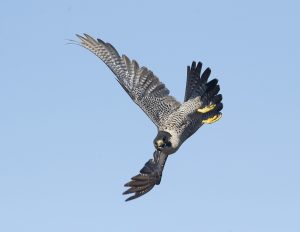 |
| Recently hatched peregrine falcon chicks. | An adult female peregrine falcon. |
